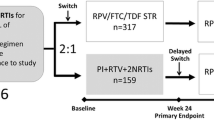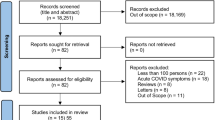Abstract
Many people living with HIV (PLWHIV) state that they would be willing to take significant risks to be “cured” of the virus. However, how they interpret the word “cure” in this context is not clear. We used a randomized survey to examine whether PLWHIV had a different willingness to take a hypothetical HIV medication if it causes flu-like symptoms, but provides: (a) cure, (b) remission that was labeled “cure”, or (c) remission. PLWHIV (n = 454) were more willing to take a medication that provided a “cure” versus a “remission” if the side effects lasted less than 1 year. PLWHIV were more willing to take a medication that provided a remission that was labeled “cure” versus a “remission” (p = 0.01) if the side effects lasted 2 weeks. Clinicians and researchers should be aware of the impact of the word “cure” and ensure that PLWHIV fully understand the possible outcomes of their treatment options.
Abstracta
Mucha gente que vive con el VIH dice que estaría dispuesta a tomar riesgos significativos para ser “curado(a)s” del virus. Sin embargo, no es claro cómo se interpreta la palabra “cura” en este contexto. Nosotros usamos una encuesta aleatoria para examinar que tanto la gente que vive con el VIH está dispuesta a tomar un medicamento hipotético para el VIH si causa síntomas como de la gripe, pero provee: a) cura, b) remisión que es etiquetada como “cura”, o c) remisión. Las personas que vive con el VIH (n = 454) estaban más dispuestas a tomar un medicamento que provee una “cura” en vez de una “remisión” si los efectos secundarios duraban menos que un año. Las personas que viven con el VIH estaban más dispuestas a tomar un medicamento que proveía una remisión que estaba etiquetada como “cura” envés de “remisión” (p = 0.01) si los efectos secundarios duraban dos semanas. Los clínicos(a)s e investigadores deben tener en cuenta el impacto de la palabra “cura” y asegurarse que la gente que vive con el VIH entienda completamente los posibles resultados de sus opciones para tratamiento.


Similar content being viewed by others
References
Rodger AJ, Lodwick R, Schechter M, Deeks S, Amin J, Gilson R, Paredes R, Bakowska E, Engsig FN, Phillips A. Mortality in well controlled HIV in the continuous antiretroviral therapy arms of the SMART and ESPRIT trials compared with the general population. Aids. 2013;27(6):973–9.
van Sighem A, Gras L, Reiss P, Brinkman K, de Wolf F. Life expectancy of recently diagnosed asymptomatic HIV-infected patients approaches that of uninfected individuals. AIDS. 2010;24(10):1527–35.
Wandeler G, Johnson LF, Egger M. Trends in life expectancy of HIV-positive adults on ART across the globe: comparisons with general population. Curr. Opinion HIVAIDS. 2016;11(5):492–500.
Gagnon M. “There is a chain of connections”: using syndemics theory to understand HIV treatment side effects. AIDS Care. 2018;30(7):910–3.
Miners A, Phillips A, Kreif N, Rodger A, Speakman A, Fisher M, et al. Health-related quality-of-life of people with HIV in the era of combination antiretroviral treatment: a cross-sectional comparison with the general population. Lancet HIV. 2014;1(1):32–40.
Wohl DA, Kuwahara RK, Javadi K, Kirby C, Rosen DL, Napravnik S, et al. Financial barriers and lapses in treatment and care of HIV-infected adults in a southern state in the United States. AIDS patient care and STDs. 2017;31(11):463–9.
Bogart LM, Cowgill BO, Kennedy D, Ryan G, Murphy DA, Elijah J, et al. HIV-related stigma among people with HIV and their families: a qualitative analysis. AIDS Behav. 2008;12(2):244–54.
Murray BR, Kratka A, Scherr KA, Eyal N, Blumenthal-Barby J, Freedberg KA, et al. What risk of death would people take to be cured of HIV and why? A survey of people living with HIV. J. Virus Eradic. 2019;5(2):109–15.
Deeks SG, Lewin SR, Ross AL, Ananworanich J, Benkirane M, Cannon P, et al. International AIDS Society global scientific strategy: towards an HIV cure 2016. Nature Med. 2016;22(8):839–50.
Spivak AM, Planelles V. HIV-1 eradication: early trials (and tribulations). Trend. Mol. Med. 2016;22(1):10–27.
FDA. HIV patient-focused drug development backgrounder document. Maryland: FDA; 2013.
International AIDS Society Scientific Working Group on HIV Cure, Deeks SG, Autran B, et al. Towards an HIV cure: a global scientific strategy. Nat. Rev. Immunol. 2012;12(8):607–14.
Gupta RK, Abdul-Jawad S, McCoy LE, Mok HP, Peppa D, Salgado M, et al. Grant P. HIV-1 remission following CCR5Δ32/Δ32 haematopoietic stem-cell transplantation. Nature. 2019;568(7751):244–8.
Yukl SA, et al. Challenges in detecting HIV persistence during potentially curative interventions: a study of the Berlin patient. PLoS Pathog. 2013;9:e1003347.
TAG. Research Toward a Cure Trials [Internet]. 2019. http://www.treatmentactiongroup.org/cure/trials. Accessed 30 Aug, 2019.
Dubé K, Luter S, Lesnar B, Newton L, Galea J, Brown B, et al. Use of ‘eradication’ in HIV cure-related research: a public health debate. BMC Pub. Health. 2018;18(1):245–51.
Henderson GE. The ethics of HIV “cure” research: what can we learn from consent forms? AIDS Res. Hum. Retrovir. 2015;31(1):56–63.
Peay HL, Henderson GE. What motivates participation in HIV cure trials? A call for real-time assessment to improve informed consent. J. Virus Erad. 2015;1(1):51–3.
Julg B, Dee L, Ananworanich J, Barouch DH, Bar K, Caskey M, et al. Recommendations for analytical antiretroviral treatment interruptions in HIV research trials—report of a consensus meeting. Lancet HIV. 2019;6:259–68.
Garner SA, Rennie S, Ananworanich J, Dube K, Margolis DM, Sugarman J, et al. Interrupting antiretroviral treatment in HIV cure research: scientific and ethical considerations. J. Virus Erad. 2017;3(2):82–4.
McMahon JH, Elliott JH, Roney J, Hagenauer M, Lewin SR. Experiences and expectations of participants completing an HIV cure focused clinical trial. AIDS. 2015;29(2):248–50.
Sylla L, Evans D, Taylor J, Gilbertson A, Palm D, Auerbach JD, et al. If we build it, will they come? Perceptions of HIV cure-related research by people living with HIV in four US cities: a qualitative focus group study. AIDS Res. Hum. Retrovir. 2018;34(1):56–66.
Krishnamurti T, Woloshin S, Schwartz LM, Fischhoff B. A randomized trial testing US Food and Drug Administration “breakthrough” language. JAMA Int. Med. 2015;175(11):1856–8.
Mena-Martin FJ, Martin-Escudero JC, Simal-Blanco F, Carretero-Ares JL, Arzua-Mouronte D, Herreros-Fernandez V. Health-related quality of life of subjects with known and unknown hypertension: results from the population-based Hortega study. J. Hypertens. 2003;21(7):1283–9.
Scherer LD, Finan C, Simancek D, Finkelstein JI, Tarini BA. Effect of “pink eye” label on parents’ intent to use antibiotics and perceived contagiousness. Clin. Pediatr. 2016;55(6):543–8.
Scherer LD, Zikmund-Fisher BJ, Fagerlin A, Tarini BA. Influence of “GERD” label on parents’ decision to medicate infants. Pediatrics. 2013;131(5):839–45.
Rennie S, Siedner M, Tucker JD, Moodley K. The ethics of talking about ‘HIV cure’. BMC Med. Ethics. 2015;16(1):18–26.
Eyal N, Kuritzkes DR. Challenges in clinical trial design for HIV-1 cure research. Lancet. 2013;382(9903):1464–5.
Pankrac J, Klein K, Mann JF. Eradication of HIV-1 latent reservoirs through therapeutic vaccination. AIDS Res. Therapy. 2017;14(1):45–9.
Acknowledgments
This research is supported by NIH Grant R56AI114617, Principal Investigator: Nir Eyal. 08/01/2014- 07/31/2019. The content is solely the responsibility of the authors and does not necessarily represent the official views of the National Institutes of Health. The funding source had NO involvement in: study design, the data collection, analysis, and interpretation of data, the writing of the report or the decision to submit the paper for publication. We are grateful to the Emory Center for AIDS Research and UCLA Medical Center for the assistance in conducting the experiment.
Author information
Authors and Affiliations
Corresponding author
Additional information
Publisher's Note
Springer Nature remains neutral with regard to jurisdictional claims in published maps and institutional affiliations.
Electronic supplementary material
Below is the link to the electronic supplementary material.
Appendix
Appendix
Intention to Take Medication
Due to skewness in the data, we also ran a non-parametric test, which indicated similar results (Kruskal–Wallis Test, χ2 = 13.60, p = 0.001); Cure group vs. Remission group (Mann–Whitney U = 9,182.00, p < .001); Cure group vs Remission labeled “Cure” group (Mann–Whitney U = 10,169.00, p = 0.10); Remission labeled “Cure” group vs. Remission group (Mann–Whitney U = 9535.50, p = 0.04).
Attitude Toward Medication
We ran a non-parametric test, that indicated similar results: Cure group provided the highest rating, Remission group provided the lowest rating, and Remission labeled “Cure” group was in between of them (Kruskal–Wallis Test, χ2 = 16.99, p = 0.00). Cure group vs. Remission group (Mann–Whitney U = 8785.50, p = 0.00). Cure group vs Remission labeled “Cure” group (Mann–Whitney U = 9579.50, p = 0.02); Remission labeled “Cure” group vs. Remission group (Mann–Whitney U = 9730.50, p = 0.08).
Intention to Take Medication by the Duration of Side Effects
In this part, we repeated analysis for the intention to take the medication with the full sample (n = 454). We evaluated the participants’ willingness to tolerate side effects for each item using a MANOVA procedure with Bonferroni adjustment to account for multiple comparisons. The MANOVA test indicated a significant difference overall, MANOVA results, F(449, 3) = 4.23, p = .00, η2 = .03. Mean differences and statistics for each item is reported in Table 4. The columns illustrate the mean difference in participants’ willingness to take the medication between each pair of groups. In all cases, the mean of the second group listed was subtracted from the mean of the first group listed. Higher numbers indicated a stronger intend to take the medication.
Rights and permissions
About this article
Cite this article
Fridman, I., Ubel, P.A., Blumenthal-Barby, J. et al. “Cure” Versus “Clinical Remission”: The Impact of a Medication Description on the Willingness of People Living with HIV to Take a Medication. AIDS Behav 24, 2054–2061 (2020). https://doi.org/10.1007/s10461-019-02769-1
Published:
Issue Date:
DOI: https://doi.org/10.1007/s10461-019-02769-1




